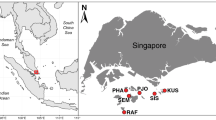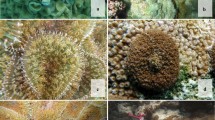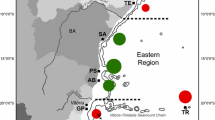Abstract
The sea anemone, Exaiptasia diaphana, previously known as Exaiptasia pallida or Aiptasia pallida, has become increasingly popular as a model for cnidarian-microbiome symbiosis studies due to its relatively rapid growth, ability to reproduce sexually and asexually, and symbiosis with diverse prokaryotes and the same microalgal symbionts (family Symbiodiniaceae) as its coral relatives. Clonal E. diaphana strains from Hawaii, the Atlantic Ocean, and Red Sea are now established for use in research. Here, we introduce Great Barrier Reef (GBR)-sourced E. diaphana strains as additions to the model repertoire. Sequencing of the 18S rRNA gene confirmed the anemones to be E. diaphana while genome-wide single nucleotide polymorphism analysis revealed four distinct genotypes. Based on Exaiptasia-specific inter-simple sequence repeat (ISSR)-derived sequence characterized amplified region (SCAR) marker and gene loci data, these four E. diaphana genotypes are distributed across several divergent phylogenetic clades with no clear phylogeographical pattern. The GBR E. diaphana genotypes comprised three females and one male, which all host Breviolum minutum as their homologous Symbiodiniaceae endosymbiont. When acclimating to an increase in light levels from 12 to 28 μmol photons m−2 s−1, the genotypes exhibited significant variation in maximum quantum yield of Symbiodiniaceae photosystem II and Symbiodiniaceae cell density. The comparatively high levels of physiological and genetic variability among GBR anemone genotypes make these animals representative of global E. diaphana diversity and thus excellent model organisms. The addition of these GBR strains to the worldwide E. diaphana collection will contribute to cnidarian symbiosis research, particularly in relation to the climate resilience of coral reefs.





Similar content being viewed by others
References
Alagely A, Krediet CJ, Ritchie KB, Teplitski M (2011) Signaling-mediated cross-talk modulates swarming and biofilm formation in a coral pathogen Serratia marcescens. ISME J 5:1609–1620. https://doi.org/10.1038/ismej.2011.45
Altschul SF, Gish W, Miller W, Myers EW, Lipman DJ (1990) Basic local alignment search tool. J Mol Biol 215:403–410. https://doi.org/10.1016/s0022-2836(05)80360-2
Arif C et al (2014) Assessing Symbiodinium diversity in scleractinian corals via next-generation sequencing-based genotyping of the ITS2 rDNA region. Mol Ecol 23:4418–4433. https://doi.org/10.1111/mec.12869
Bainbridge SJ (2017) Temperature and light patterns at four reefs along the great barrier reef during the 2015–2016 austral summer: understanding patterns of observed coral bleaching. J Oper Oceanogr 10:16–29. https://doi.org/10.1080/1755876X.2017.1290863
Baird AH, Bhagooli R, Ralph PJ, Takahashi S (2009) Coral bleaching: the role of the host. Trends Ecol Evol 24:16–20. https://doi.org/10.1016/j.tree.2008.09.005
Baumgarten S et al (2015) The genome of Aiptasia, a sea anemone model for coral symbiosis. Proc Natl Acad Sci U S A 112:11893–11898. https://doi.org/10.1073/pnas.1513318112
Belda-Baillie CA, Baillie BK, Maruyama T (2002) Specificity of a model cnidarian-dinoflagellate symbiosis. Biol Bull 202:74–85. https://doi.org/10.2307/1543224
Bellis ES, Denver DR (2017) Natural variation in responses to acute heat and cold stress in a sea anemone model system for coral bleaching. Biol Bull 233:168–181. https://doi.org/10.1086/694890
Blanquet R, Lenhoff HM (1966) A disulfide-linked collagenous protein of nematocyst capsules. Science 154:152–153
Bolyen E et al. (2018) QIIME 2: reproducible, interactive, scalable, and extensible microbiome data science. PeerJ Preprints
Bradford MM (1976) A rapid and sensitive method for the quantitation of microgram quantities of protein utilizing the principle of protein-dye binding. Anal Biochem 72:248–254
Bucher M, Wolfowicz I, Voss PA, Hambleton EA, Guse A (2016) Development and Symbiosis Establishment in the Cnidarian Endosymbiosis Model Aiptasia sp. Sci Rep 6:19867. https://doi.org/10.1038/srep19867
Callahan BJ, McMurdie PJ, Rosen MJ, Han AW, Johnson AJA, Holmes SP (2016) DADA2: high-resolution sample inference from Illumina amplicon data. Nat Methods 13:581
Carlisle JF, Murphy GK, Roark AM (2017) Body size and symbiotic status influence gonad development in Aiptasia pallida anemones. Symbiosis 71:121–127. https://doi.org/10.1007/s13199-016-0456-1
Chen C, Soong K, Chen CA (2008) The smallest oocytes among broadcast-spawning actiniarians and a unique lunar reproductive cycle in a unisexual population of the sea anemone, Aiptasia pulchella (Anthozoa : Actiniaria). Zool Stud 47:37–45
Cruz VM, Kilian A, Dierig DA (2013) Development of DArT marker platforms and genetic diversity assessment of the U.S. collection of the new oilseed crop lesquerella and related species. PLoS One 8:e64062. https://doi.org/10.1371/journal.pone.0064062
Cunning R, Baker AC (2012) Excess algal symbionts increase the susceptibility of reef corals to bleaching. Nat Clim Chang 3:259–262. https://doi.org/10.1038/nclimate1711
Cunning R, Baker AC (2014) Not just who, but how many: the importance of partner abundance in reef coral symbioses. Front Microbiol 5:400. https://doi.org/10.3389/fmicb.2014.00400
Cziesielski MJ, Liew YJ, Cui G, Schmidt-Roach S, Campana S, Marondedze C, Aranda M (2018) Multi-omics analysis of thermal stress response in a zooxanthellate cnidarian reveals the importance of associating with thermotolerant symbionts. Proc Biol Sci 285. https://doi.org/10.1098/rspb.2017.2654
Damjanovic K, Blackall LL, Webster NS, van Oppen MJH (2017) The contribution of microbial biotechnology to mitigating coral reef degradation. Microb Biotechnol 10:1236–1243. https://doi.org/10.1111/1751-7915.12769
Davis RH (2004) The age of model organisms. Nat Rev Genet 5:69–76. https://doi.org/10.1038/nrg1250
Davy SK, Allemand D, Weis VM (2012) Cell biology of cnidarian-dinoflagellate symbiosis. Microbiol Mol Biol Rev 76:229–261. https://doi.org/10.1128/MMBR.05014-11
De'ath G, Fabricius KE, Sweatman H, Puotinen M (2012) The 27-year decline of coral cover on the great barrier reef and its cause.s. Proc Natl Acad Sci U S A 109:17995–17999. https://doi.org/10.1073/pnas.1208909109
Duckworth CG, Picariello CR, Thomason RK, Patel KS, Bielmyer-Fraser GK (2017) Responses of the sea anemone, Exaiptasia pallida, to ocean acidification conditions and zinc or nickel exposure. Aquat Toxicol 182:120–128. https://doi.org/10.1016/j.aquatox.2016.11.014
Eakin CM et al (2016) Global coral bleaching 2014-2017 status and an appeal for observations reef. Encounter 31:20–26
Fabricius K, De’ath G, McCook L, Turak E, Williams DM (2005) Changes in algal, coral and fish assemblages along water quality gradients on the inshore great barrier reef. Mar Pollut Bull 51:384–398
Fadlallah Y, Pearse J (1982) Sexual reproduction in solitary corals: overlapping oogenic and brooding cycles, and benthic planulas in Balanophyllia elegans. Mar Biol 71:223–231
Falkowski PG, Dubinsky Z, Muscatine L, Mccloskey L (1993) Population-control in symbiotic corals. BioScience 43:606–611. https://doi.org/10.2307/1312147
Franklin DJ, Hoegh-Guldberg O, Jones R, Berges JA (2004) Cell death and degeneration in the symbiotic dinoflagellates of the coral Stylophora pistillata during bleaching. Mar Ecol Prog Ser 272:117–130
Fransolet D, Roberty S, Plumier J-C (2014) Impairment of symbiont photosynthesis increases host cell proliferation in the epidermis of the sea anemone Aiptasia pallida. Mar Biol 161:1735–1743. https://doi.org/10.1007/s00227-014-2455-1
Gates RD, Baghdasarian G, Muscatine L (1992) Temperature stress causes host cell detachment in symbiotic cnidarians: implications for coral bleaching. Biol Bull 182:324–332
Goffredo S, Marchini C, Rocchi M, Airi V, Caroselli E, Falini G, Levy O, Dubinsky Z, Zaccanti F (2012) Unusual pattern of embryogenesis of Caryophyllia inornata (scleractinia, caryophylliidae) in the mediterranean sea: maybe agamic reproduction? J Morphol 273:943–956
Goyen S, Pernice M, Szabó M, Warner ME, Ralph PJ, Suggett DJ (2017) A molecular physiology basis for functional diversity of hydrogen peroxide production amongst Symbiodinium spp.(Dinophyceae). Mar Biol 164:46
Grajales A, Rodriguez E (2014) Morphological revision of the genus Aiptasia and the family Aiptasiidae (Cnidaria, Actiniaria, Metridioidea). Zootaxa 3826:55–100. https://doi.org/10.11646/zootaxa.3826.1.2
Grajales A, Rodriguez E (2016) Elucidating the evolutionary relationships of the Aiptasiidae, a widespread cnidarian-dinoflagellate model system (Cnidaria: Anthozoa: Actiniaria: Metridioidea). Mol Phylogenet Evol 94:252–263. https://doi.org/10.1016/j.ympev.2015.09.004
Grawunder D, Hambleton EA, Bucher M, Wolfowicz I, Bechtoldt N, Guse A (2015) Induction of Gametogenesis in the Cnidarian Endosymbiosis Model Aiptasia sp. Sci Rep 5:15677. https://doi.org/10.1038/srep15677
Gruber B, Georges A, Berry O, Unmack P (2017) dartR: importing and Analysing Snp and Silicodart data generated by genome-wide restriction fragment analysis. CRAN
Hawkins TD, Hagemeyer JC, Warner ME (2016a) Temperature moderates the infectiousness of two conspecific Symbiodinium strains isolated from the same host population. Environ Microbiol 18:5204–5217
Hawkins TD, Hagemeyer JCG, Hoadley KD, Marsh AG, Warner ME (2016b) Partitioning of respiration in an animal-algal symbiosis: implications for different aerobic capacity between symbiodinium spp. Front Physiol 7:128. https://doi.org/10.3389/fphys.2016.00128
Hillyer KE, Dias DA, Lutz A, Roessner U, Davy SK (2017) Mapping carbon fate during bleaching in a model cnidarian symbiosis: the application of 13 C metabolomics. New Phytol 214:1551–1562. https://doi.org/10.1111/nph.14515
Hoadley KD, Warner ME (2017) Use of open source hardware and software platforms to quantify spectrally dependent differences in photochemical efficiency and functional absorption cross section within the dinoflagellate symbiodinium spp. Front Mar Sci 4. https://doi.org/10.3389/fmars.2017.00365
Hoadley KD, Rollison D, Pettay DT, Warner ME (2015) Differential carbon utilization and asexual reproduction under elevatedpCO2conditions in the model anemone,Exaiptasia pallida, hosting different symbionts. Limnol Oceanogr 60:2108–2120. https://doi.org/10.1002/lno.10160
Hothorn T, Bretz F, Westfall P, Heiberger RM, Schuetzenmeister A, Scheibe S, Hothorn MT (2016) Package ‘multcomp’ simultaneous inference in general parametric models project for statistical computing, Vienna, Austria
Howe PL, Reichelt-Brushett AJ, Clark MW, Seery CR (2017) Toxicity estimates for diuron and atrazine for the tropical marine cnidarian Exaiptasia pallida and in-hospite Symbiodinium spp. using PAM chlorophyll-a fluorometry. J Photochem Photobiol B 171:125–132. https://doi.org/10.1016/j.jphotobiol.2017.05.006
Howells E, Beltran V, Larsen N, Bay L, Willis B, Van Oppen M (2012) Coral thermal tolerance shaped by local adaptation of photosymbionts. Nat Clim Chang 2:116
Hughes TP et al (2017) Global warming and recurrent mass bleaching of corals. Nature 543:373–377. https://doi.org/10.1038/nature21707
Hughes TP et al (2018) Global warming transforms coral reef assemblages. Nature 556:492–496. https://doi.org/10.1038/s41586-018-0041-2
ICZN (2017) Opinion 2404 (Case 3633) —Dysactis pallida Agassiz in Verrill, 1864 (currently Aiptasia pallida; Cnidaria, Anthozoa, Hexacorallia, Actiniaria): precedence over Aiptasia diaphana (Rapp, 1829), Aiptasia tagetes (Duchassaing de Fombressin & Michelotti, 1864), Aiptasia mimosa (Duchassaing de Fombressin & Michelotti, 1864) and Aiptasia inula (Duchassaing de Fombressin & Michelotti, 1864) not approved The Bulletin of Zoological Nomenclature 74:130–132, 133
Kearse M et al (2012) Geneious basic: an integrated and extendable desktop software platform for the organization and analysis of sequence data. Bioinformatics (Oxford, England) 28:1647–1649. https://doi.org/10.1093/bioinformatics/bts199
Kenkel CD, Bay LK (2018) Exploring mechanisms that affect coral cooperation: symbiont transmission mode, cell density and community composition bioRxiv:067322. https://doi.org/10.1101/067322
Kumar S, Stecher G, Li M, Knyaz C, Tamura K (2018) MEGA X: molecular evolutionary genetics analysis across computing platforms. Mol Biol Evol 35:1547–1549
LaJeunesse TC, Parkinson JE, Gabrielson PW, Jeong HJ, Reimer JD, Voolstra CR, Santos SR (2018) Systematic revision of Symbiodiniaceae highlights the antiquity and diversity of coral Endosymbionts. Curr Biol 28:2570–2580.e2576. https://doi.org/10.1016/j.cub.2018.07.008
Lehnert EM, Burriesci MS, Pringle JR (2012) Developing the anemone Aiptasia as a tractable model for cnidarian-dinoflagellate symbiosis: the transcriptome of aposymbiotic a. pallida. BMC Genomics 13:271. https://doi.org/10.1186/1471-2164-13-271
Lehnert EM, Mouchka ME, Burriesci MS, Gallo ND, Schwarz JA, Pringle JR (2014) Extensive differences in gene expression between symbiotic and aposymbiotic cnidarians G3 (Bethesda) 4:277–295. https://doi.org/10.1534/g3.113.009084
Melville J et al (2017) Identifying hybridization and admixture using SNPs: application of the DArTseq platform in phylogeographic research on vertebrates. R Soc Open Sci 4:161061
Muller-Parker G, Cook CB, D'Elia CF (1990) Feeding affects phosphate fluxes in the symbiotic sea anemone Aiptasia pallida. Mar Ecol Prog Ser 60:283–290
Muscatine L, Porter JW (1977) Reef corals: mutualistic symbioses adapted to nutrient-poor environments. Bioscience 27:454–460
Nei M, Kumar S (2000) Molecular evolution and phylogenetics. Oxford University Press
O’Mahony J, Simes R, Redhill D, Heaton K, Atkinson C, Hayward E, Nguyen M (2017) At what price? The economic, social and icon value of the great barrier reef. Deloitte Access Economics, Brisbane, QLD, Australia
Perez SF, Cook CB, Brooks WR (2001) The role of symbiotic dinoflagellates in the temperature-induced bleaching response of the subtropical sea anemone Aiptasia pallida. J Exp Mar Biol Ecol 256:1–14
Pinheiro J, Bates D, DebRoy S, Sarkar D, Heisterkamp S, Van Willigen B, Maintainer R (2017) Package ‘nlme’ Linear and Nonlinear Mixed Effects Models, version:3–1
Pochon X, Pawlowski J, Zaninetti L, Rowan R (2001) High genetic diversity and relative specificity among Symbiodinium-like endosymbiotic dinoflagellates in soritid foraminiferans. Mar Biol 139:1069–1078. https://doi.org/10.1007/s002270100674
Rädecker N et al (2018) Using Aiptasia as a model to study metabolic interactions in cnidarian-Symbiodinium symbioses. Front Physiol 9:214–214. https://doi.org/10.3389/fphys.2018.00214
Ragni M, Airs RL, Hennige SJ, Suggett DJ, Warner ME, Geider RJ (2010) PSII photoinhibition and photorepair in Symbiodinium (Pyrrhophyta) differs between thermally tolerant and sensitive phylotypes. Mar Ecol Prog Ser 406:57–70
Rapp W (1829) Über die Polypen im Allgemeinen und die Actinien Verlag des Großherzoglich Sächsischen privileg Landes-Industrie-Comptoirs, Weimar
Rognes T, Flouri T, Nichols B, Quince C, Mahé F (2016) VSEARCH: a versatile open source tool for metagenomics. PeerJ 4:e2584
Rohwer F, Seguritan V, Azam F, Knowlton N (2002) Diversity and distribution of coral-associated bacteria. Mar Ecol Prog Ser 243:10
Rosado PM et al (2018) Marine probiotics: increasing coral resistance to bleaching through microbiome manipulation. ISME J. https://doi.org/10.1038/s41396-018-0323-6
Schlesinger A, Kramarsky-Winter E, Rosenfeld H, Armoza-Zvoloni R, Loya Y (2010) Sexual plasticity and self-fertilization in the sea anemone Aiptasia diaphana. PLoS One 5:e11874. https://doi.org/10.1371/journal.pone.0011874
Stat M, Pochon X, Cowie RO, Gates RD (2009) Specificity in communities of Symbiodinium in corals from Johnston Atoll. Mar Ecol Prog Ser 386:83–96
Steele RD (1976) Light intensity as a factor in the regulation of the density of symbiotic zooxanthellae in Aiptasia tagetes (Coelenterata, Anthozoa). J Zool 179:387–405. https://doi.org/10.1111/j.1469-7998.1976.tb02302.x
Suggett DJ, Warner ME, Smith DJ, Davey P, Hennige S, Baker NR (2008) Photosynthesis and production of hydrogen peroxide by Symbiodinium (pyrrhophyta) phylotypes with different thermal tolerances 1. J Phycol 44:948–956
Sunagawa S, Wilson EC, Thaler M, Smith ML, Caruso C, Pringle JR, Weis VM, Medina M, Schwarz JA (2009) Generation and analysis of transcriptomic resources for a model system on the rise: the sea anemone Aiptasia pallida and its dinoflagellate endosymbiont. BMC Genomics 10:258. https://doi.org/10.1186/1471-2164-10-258
Team RC (2013) R: a language and environment for statistical computing
Thornhill DJ, Xiang Y, Pettay DT, Zhong M, Santos SR (2013) Population genetic data of a model symbiotic cnidarian system reveal remarkable symbiotic specificity and vectored introductions across ocean basins. Mol Ecol 22:4499–4515. https://doi.org/10.1111/mec.12416
Tortorelli G, Belderok R, Davy SK, McFadden GI, van Oppen MJ (2019) Host genotypic effect on algal symbiosis establishment in the coral model, the anemone Exaiptasia diaphana, from the great barrier reef. Front Mar Sci 6:833
Verrill AE Revision of the polypi of the eastern coast of the United States. In, 1864. Boston Society of Natural History
Wangpraseurt D, Larkum AW, Franklin J, Szabo M, Ralph PJ, Kuhl M (2014) Lateral light transfer ensures efficient resource distribution in symbiont-bearing corals. J Exp Biol 217:489–498. https://doi.org/10.1242/jeb.091116
Weis VM, Davy SK, Hoegh-Guldberg O, Rodriguez-Lanetty M, Pringle JR (2008) Cell biology in model systems as the key to understanding corals. Trends Ecol Evol 23:369–376. https://doi.org/10.1016/j.tree.2008.03.004
Wilson K et al (2002) Genetic mapping of the black tiger shrimp Penaeus monodon with amplified fragment length polymorphism. Aquaculture 204:297–309. https://doi.org/10.1016/S0044-8486(01)00842-0
Xiang T, Hambleton EA, DeNofrio JC, Pringle JR, Grossman AR (2013) Isolation of clonal axenic strains of the symbiotic dinoflagellate Symbiodinium and their growth and host specificity(1). J Phycol 49:447–458. https://doi.org/10.1111/jpy.12055
Ziegler M, Roder CM, Büchel C, Voolstra CR (2015) Mesophotic coral depth acclimatization is a function of host-specific symbiont physiology. Front Mar Sci 2:4
Acknowledgments
This research was funded by Australian Research Council Discovery Project grants DP160101468 (to MJHvO and LLB) and DP160101539 (to GIM and MJHvO). We thank Lesa Peplow for facilitating transport of the initial anemone cultures from AIMS to SUT and UoM and Rebecca Alfred from SUT for initial anemone culture maintenance. We acknowledge Anton Cozijnsen, Keren Maor-Landaw, Samantha Girvan, Ruby Vanstone and Gabriela Rodriguez from University of Melbourne for assisting with anemone husbandry and Laura Leone, Lisa Foster, and Lona Dinha from the Melbourne Histology Platform for histological sample preparation and sectioning. SCAR marker reference sequences were provided by Dan Thornhill and Liz Hambleton (AG Guse Lab, Centre for Organismal Studies (COS), Universität Heidelberg). MJHvO acknowledges Australian Research Council Laureate Fellowship FL180100036.
Author information
Authors and Affiliations
Corresponding author
Additional information
Publisher’s note
Springer Nature remains neutral with regard to jurisdictional claims in published maps and institutional affiliations.
Rights and permissions
About this article
Cite this article
Dungan, A.M., Hartman, L.M., Tortorelli, G. et al. Exaiptasia diaphana from the great barrier reef: a valuable resource for coral symbiosis research. Symbiosis 80, 195–206 (2020). https://doi.org/10.1007/s13199-020-00665-0
Received:
Accepted:
Published:
Issue Date:
DOI: https://doi.org/10.1007/s13199-020-00665-0




